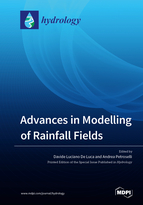Advances in Modelling of Rainfall Fields
A special issue of Hydrology (ISSN 2306-5338). This special issue belongs to the section "Hydrological and Hydrodynamic Processes and Modelling".
Deadline for manuscript submissions: closed (15 May 2022) | Viewed by 52404
Special Issue Editors
Interests: stochastic processes; rainfall fields modelling; mathematics; statistics; GIS; early warning systems
Interests: rainfall-runoff modeling; flood prone area estimation; surface hydrology; GIS terrain analysis for hydrogeomorphic applications; hydrological processes monitoring and modelling
Special Issues, Collections and Topics in MDPI journals
Special Issue Information
Dear Colleagues,
Rainfall is the main input for all hydrological models such as, for example, rainfall-runoff models and forecasting of landslides triggered by precipitation. Consequently, the need of improving the modelling of rainfall fields constitutes a key aspect for i) realizing efficient early warning systems and ii) carrying out analyses of future scenarios related to occurrences and magnitudes for all the induced phenomena.
The aim of this Special Issue is to provide a collection of innovative contributions for rainfall modelling, focusing on hydrological scales and on a context of climate changes. In particular, the following topics are of interest:
- Statistical analysis of rainfall extremes, mainly focusing on Intensity-Duration-Frequency (IDF) curves and evaluation of Rainfall Thresholds;
- Temporal and spatial rainfall distribution;
- Transient Stochastic Rainfall Generators, suitable for obtaining long and perturbed time series into a context of climate changes;
- Models for rainfall nowcasting at hydrological scales, which can also couple several data sources (from rain gauge networks, weather radar, outputs from Limited Area Models) into a Bayesian framework;
- Rainfall downscaling
Dr. Davide Luciano De Luca
Assoc. Prof. Andrea Petroselli
Guest Editor
Manuscript Submission Information
Manuscripts should be submitted online at www.mdpi.com by registering and logging in to this website. Once you are registered, click here to go to the submission form. Manuscripts can be submitted until the deadline. All submissions that pass pre-check are peer-reviewed. Accepted papers will be published continuously in the journal (as soon as accepted) and will be listed together on the special issue website. Research articles, review articles as well as short communications are invited. For planned papers, a title and short abstract (about 100 words) can be sent to the Editorial Office for announcement on this website.
Submitted manuscripts should not have been published previously, nor be under consideration for publication elsewhere (except conference proceedings papers). All manuscripts are thoroughly refereed through a single-blind peer-review process. A guide for authors and other relevant information for submission of manuscripts is available on the Instructions for Authors page. Hydrology is an international peer-reviewed open access monthly journal published by MDPI.
Please visit the Instructions for Authors page before submitting a manuscript. The Article Processing Charge (APC) for publication in this open access journal is 1800 CHF (Swiss Francs). Submitted papers should be well formatted and use good English. Authors may use MDPI's English editing service prior to publication or during author revisions.
Keywords
- IDF curves
- Return period
- Rainfall thresholds
- Temporal and spatial rainfall distribution
- Stochastic Rainfall Generators
- Bayesian framework
- Rainfall nowcasting
- Rainfall downscaling







